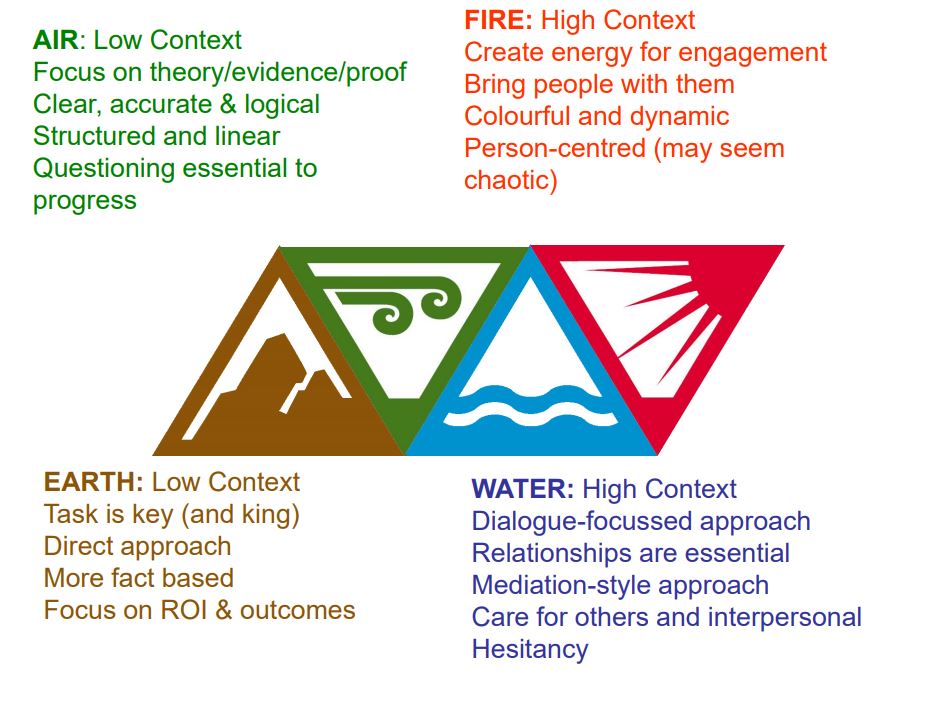TetraMap and cultural synergy
 by guest blogger Leyla Okhai, DIverse Minds UK Ltd
by guest blogger Leyla Okhai, DIverse Minds UK Ltd
Understanding culture and cultural reference points have a constant theme throughout my life. As a woman with South Asian heritage via South East Africa, born in the US and having lived in the UK for 26 years it has been a journey to understand my own culturally nuances behaviour and that of others. In my professional life, I have worked in the arena of equality, diversity, and inclusion for over 15 years in a number of universities in the UK. Needless to say, global education spaces have a multitude of cultures and sub-cultures within them.
What is culture?
So, what is culture then? Can it be summarised in a succinct way? For me, culture is all the aspects that define you as an individual. This ranges from your core values, your race, your gender, your educational experience, your religion or non-religious beliefs, social class, languages, you speak etc. Of course, there will be more cultural commonalities depending on where in the world you live. The Oxford English Dictionary states “Culture is the ideas, customs, and social behaviour of a particular people or society.” With the world effectively shrinking due to digital communication and working globally, it is essential to understand how to communicate as effectively as possible with respect.
Culture and TetraMap
I trained as a TetraMap facilitator in November 2016 and it became apparent that TetraMap could be used as a way to link the elements to cultural preference. I have developed and run many leadership programmes for Black and Asian minority ethnic staff (BAME) and I use TetraMap as a way to support delegates’ leadership journeys. The beauty of TetraMap is the discussion it generates to encourage people to understand each other. It also enables delegates to reflect on the dominant element in their team (sub-culture) and what they may need to do differently to be heard, receive recognition or work on that all-important project.
High and Low Context cultures
Using Edward T. Hall’s work on low and high context culture, delegates gain an appreciation of how their personal culture, often reflecting their cultural heritage could be in conflict with the culture at work and their “professional selves”. High and low context culture can be summarised as follows:
| High Context | Low Context | |
| Less direct communication- more nuanced with an emphasis on body language and what is unsaid | More direct communication that is specific and precise | |
| Human relationships are key for a project to work | Human relationships are more transactional to get the job done | |
| Cultural knowledge is more implicit and could be less tangible | Cultural knowledge is more explicit | |
| Longer term relationships | Short-term relationships | |
| Fewer written rules of operation and how to carry out a task | More explicit rules of operation | |
| Country examples: Japan, India, Latin America, UAE, Brazil | Country examples: Germany, Switzerland, UK, USA, Canada |
This can be a helpful framework to understand how misunderstandings and miscommunications occur. It is also important to note, that many of us operate straddling two cultures, particularly pertinent for diaspora communities in the West where it is likely we have been raised in a high-context way, who then have to operate in a low context culture, which can feel very uncomfortable. Naturally, this also applies to people from a low context culture who have to operate in a high context way. This creates blocks in identifying how to make a shift to progress and get the most from the workplace. The way in which I have mapped this onto the TetraMap can be seen below.

The Four Elements of Culture – created by Leyla Okhai
Culture is fluid, changing and adapting all the time. I invite you to consider how to make the most of your culture and elemental preferences to understand the culture of those around you. Not just for productivity, but to enhance exchanges and deepen relationships.
This blog follows-on from a TetraMap Facilitators Teach and Learn webinar I gave.
Comments
Leave a Reply
You must be logged in to post a comment.
Absolutely terrific content Leyla, and explained in a way that makes a complex topic simple to understand. Just like TetraMap itself!